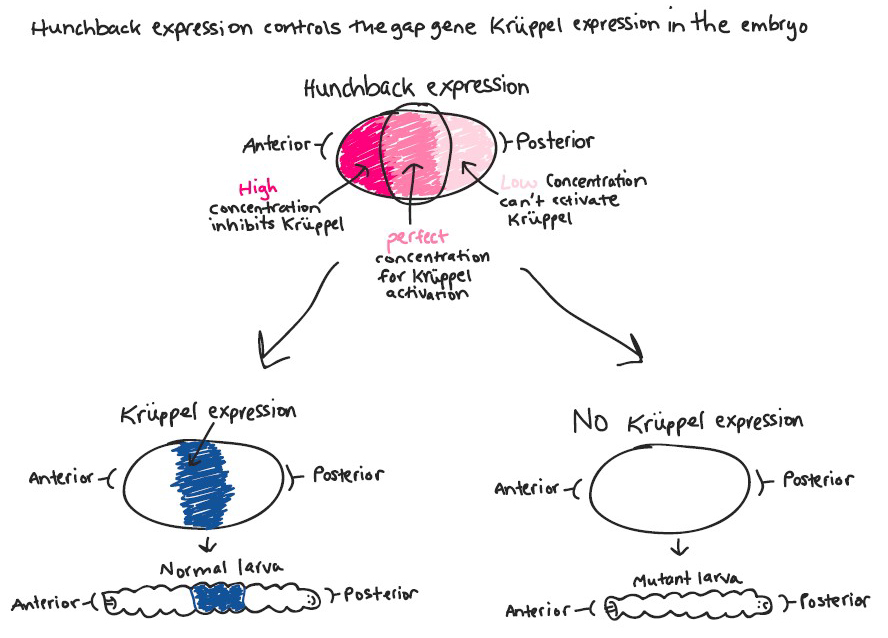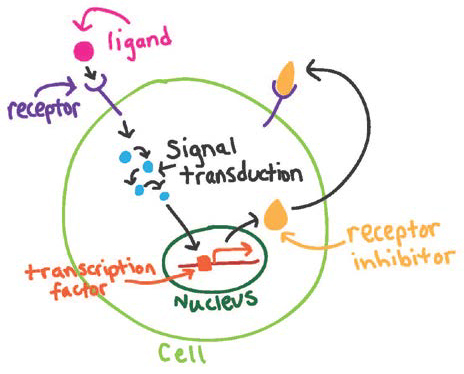CHAPTER SUMMARY
20.1 IN THE DEVELOPMENT OF HUMANS AND OTHER ANIMALS, STEM CELLS BECOME PROGRESSIVELY MORE RESTRICTED IN THEIR POSSIBLE PATHWAYS OF CELLULAR DIFFERENTIATION.
- The fertilized egg can give rise to a complete organism.
- At each successive stage in development, cells lose developmental potential as they become differentiated.
- Embryonic stem cells can give rise to any of the three germ layers, those further along in differentiation can form only a limited number of specialized cell types, and those still further along can form only one cell type.
- Stem cells play a prominent role in regenerative medicine, which uses stem cells—in some cases reprogrammed cells from the patient’s own body—to replace diseased or damaged tissues.
20.2 THE GENETIC CONTROL OF DEVELOPMENT IS A HIERARCHY IN WHICH GENES ARE DEPLOYED IN GROUPS THAT IN TURN REGULATE THE NEXT SET OF GENES.
- Hierarchical gene control can be seen in fruit fly (Drosophila) development.
- The oocyte of a fruit fly is highly polarized, with gradients of mRNA established by the mother that set up anterior–posterior and dorsal–ventral axes.
- These gradients in turn affect the expression of segmentation genes in the zygote, including the gap, pair-rule, and segment-polarity genes, which define specific regions in the developing embryo.
- The segmentation genes direct the expression of homeotic genes, key transcription factors that specify the identity of each segment of the fly and that are conserved in animal development.
20.3 MANY PROTEINS THAT PLAY KEY ROLES IN DEVELOPMENT ARE EVOLUTIONARILY CONSERVED BUT CAN HAVE DRAMATICALLY DIFFERENT EFFECTS IN DIFFERENT ORGANISMS.
- Many proteins important in development are similar in sequence from one organism to the next. They are said to be evolutionarily conserved.
- The downstream targets, or cis-regulatory elements, of homeotic genes are different in different animals, allowing homeotic genes to activate different developmental pathways in different organisms.
- Although animals exhibit an enormous diversity in eye morphology, the observation that the proteins involved in light perception are evolutionarily conserved suggests that the ability to perceive light may have evolved once, early in the evolution of animals.
- The Pax6 transcription factor is a master regulator of eye development. Loss-of-function mutations in Pax6 result in abnormalities in eye development, whereas gain-of-function mutations result in eye development in tissues in which eyes do not normally form.
20.4 COMBINATORIAL CONTROL IS A DEVELOPMENTAL STRATEGY IN WHICH THE PATHWAY OF CELLULAR DIFFERENTIATION DEPENDS ON THE PARTICULAR COMBINATION OF TRANSCRIPTION FACTORS PRESENT IN A CELL.
- By analyzing mutants that affect flower development in the plant Arabidopsis, researchers were able to determine the genes involved in normal flower development.
- The ABC model of flower development invokes three activities (A, B, and C) present in circular regions (whorls) of the developing flower, with the specific combination of factors determining the developmental pathway in each whorl.
20.5 LIGAND–RECEPTOR INTERACTIONS ACTIVATE SIGNAL TRANSDUCTION PATHWAYS THAT CONVERGE ON TRANSCRIPTION FACTORS AND OTHER GENES THAT DETERMINE CELL FATE.
- Cell signaling involves a ligand, an extracellular molecule that acts as a signal to activate a membrane receptor protein, which in turn activates molecules inside the cell.
- Activation of a receptor sets off a pathway of signal transduction, in which a series of proteins in the cytoplasm become sequentially activated.
- Because signal transduction can amplify and expand a developmental signal, a single ligand–receptor pair can cause major changes in gene expression and ultimately determine the pathway of differentiation.
- An example of signal transduction in development is differentiation of the nematode vulva, which is determined by means of an EGF ligand and receptor.
Self-Assessment Question 1
Distinguish among totipotent, pluripotent, and multipotent stem cells, and give an example of where you would find each type of cell.
Show Model Answer
Model Answer:
Totipotent cells can give rise to a complete organism and can be found in a fertilized egg, before it develops into a blastocyst. Pluripotent cells are able to give rise to any of the three germ layers, and therefore to any cell of the body, but cannot give rise to an entire organism. Embryonic stem cells are pluripotent and can be found in the inner cell mass of the blastocyst. Multipotent cells are further along in differentiation than pluripotent cells and can form a limited number of specialized cell types. The cells of the mesoderm are multipotent, and differentiate into skin, muscle, bone, and red blood cells, and can be found in the gastrula.
Self-Assessment Question 2
Explain how an individual’s own cells might be used in stem cell therapy.
Show Model Answer
Model Answer:
Stem cell therapy for an individual might someday consist of taking that person’s own adult cells and reprogramming them, through various methods, into pluripotent and multipotent stem cells. These cells could be programmed to replace burned tissue, defective heart muscle, regenerate nerve cells, etc. The possibilities of this technology are great.
Self-Assessment Question 3
Draw a diagram to illustrate how overlapping domains of gap gene expression along the anterior–posterior axis of a Drosophila embryo can create a series of segments, each expressing a unique combination of gap genes.
Show Model Answer
Model Answer:
See below diagram.

Self-Assessment Question 4
Explain the role of homeotic genes in Drosophila development, and describe one phenotype in Drosophila resulting from a mutation in a homeotic gene that leads to development of a body part in an inappropriate segment.
Show Model Answer
Model Answer:
A homeotic gene is a gene that specifies the identity of a body part or segment during embryonic development. A mutation in Bithorax causes the fruit fly to have two T2 segments in a row and thus two pairs of wings.
Self-Assessment Question 5
Explain why some genes, particularly those involved in the early stages of development, are evolutionarily conserved.
Show Model Answer
Model Answer:
Some genes are evolutionarily conserved because they carry out a vital function. For example, the development of eyes (from planaria to humans) have evolutionarily conserved genes because sight is a desirable trait in order to survive and reproduce in ones environment.
Self-Assessment Question 6
Define combinatorial control in the context of the ABC model of floral development.
Show Model Answer
Model Answer:
Combinatorial control describes the regulation of gene transcription according to the mix of transcription factors in the cell. In the floral development ABC model, “A” transcription factors are involved in the development of whorl 1 and 2, “B” transcription factors are involved in whorl 2 and 3, and “C” transcription factors are involved in whorl 3 and 4 development. In whorl 3, for example, both sets of transcription factors (“B” and “C”) have to be present for the formation of the stamen of the flower.
Self-Assessment Question 7
Diagram a pathway of signal transduction including a ligand, receptor, and ultimately a transcription factor that activates a gene that inhibits the receptor.
Show Model Answer
Model Answer:
See attached diagram.
